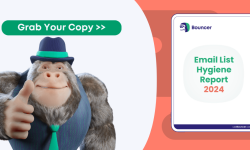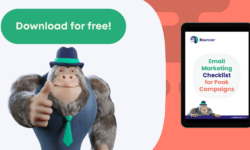A Call to Action (CTA) is a key phrase used by marketing departments. We explain what this important term means. Additionally, we provide some of the best examples of how to achieve it.
What Is a Call to Action (or Sometimes a Call for Action)?
There is a difference between a call to action and a call to action that converts. A call to action is a button or phrase for the consumer to click on. This could be to subscribe to a newsletter or mailing list or even to download a pdf with important information that the consumer will appreciate. You can think of a call to action as a nudge the marketer gives consumers to get them to act. These actions lead them through steps that bring them closer to buying your product. Your conversion strategy will determine which steps you want consumers to take and in what order. For example, signing up for your mailing list and then going to your products page.
What a Call to Action Is When It Converts
The ultimate goal of a call to action is conversion. What does this mean? The consumer responds to the call for action by purchasing the product or signing up for the service. In other words, a call to action converts into a sale.
A Simple Call to Action Example
The simplest call to action is “Buy Now”. When the consumer clicks on this button, they are taken to the payment page to complete the transaction. This is the primary end goal of a call to action. The consumer has now become a customer that you can focus on retaining.
Where Are Calls for Action Placed?
Most marketers know the importance of generating content to build relationships with consumers and increase brand recognition. These content items include videos, podcasts, blog posts, and social media posts, as the most common ones.
With all this content you are creating, how do you know where to place your calls to action? They are usually placed as opt-in campaign buttons, web-page buttons, email buttons or text, blogs as anchor text, and in the text of social media posts. We examine each of these briefly below.
Opt-in Campaign Buttons
These can take the form of a floating bar, slide-in-box, popup, etc. What you include in it needs to be pithy. You have a small space to make a significant impact, so think of a catchy one-liner and offer a discount. This offer can be repeated under the button as well, and a red arrow pointing to the field where they must insert their email address is effective. Even though the campaign aimed to get the consumer to provide their email address, thus opting-in to receiving further communication from you, the repetition of the discount offer under the email address field could state, “get your 30% discount code”. If the consumer clicks on this button, while it is not yet a commitment to buy, it expresses a potential interest in making a purchase to benefit from the discount.
Web-page Buttons
Most calls to action buttons on web pages incorporate features like a call widget, which is another common and effective conversion tool.
These need to stand out from the text and draw immediate attention through colour, size, a red arrow pointing to the field where the action is taken (for example), and a persuasive heading. The actual button needs to be large enough for mobile phone users to click on with a finger.
Email Buttons or Text
Emails are an excellent way to build relationships with consumers. The purpose of the email may be to get the reader to download a resource, read an article, obtain further information, or benefit from a free offer or discount.
You will want to follow the suggestions for an effective opt-in campaign in designing the button and text for an email. It must be short, compelling, and encourage the desired action. Use of colour, etc., as already mentioned, will ensure that the reader of the email is drawn to this button.
Anchor Text in Blogs
The anchor text has a link to another site belonging to the company. Getting the consumer to click on the link moves them further along the pipe to a conversion. At both ends, there is a call to action. The first, in the blog, is a link to another page and surrounding text to encourage clicking on the link. For example, the other call to action could be a product page with buttons for each model. Other links may provide in-depth information on aspects of the blog topic. This enhances the user experience (UX).
Social Media Buttons or Text
In social media, you compete with a deluge of other posts and users scrolling quickly until something catches their attention. A simple picture and short text must be combined with a clear call to action. The use of suspense or intrigue in the text can grab the attention you need to keep the user on your post long enough to comply with your call to action.
Examples of Successful Calls to Action for Conversion
We have covered what a call to action is and differentiated a call to action that gets readers to join a mailing list, e.g., from a call to action that leads to conversion. Placements of calls to action have also been covered. Now we provide some recent (2022) examples of successful calls to action that led to higher conversion rates.
The Budgetnista
The Budgetnista call to action consists of a photo of the owner on the right-hand side and text on the left-hand side. The text heading says, “Get FREE Weekly Goodies!”. This heading ensures that the reader will read the rest of the text to see whether they want these gifts. It is captivating, as is the call-to-action button, which states, “Sign Up For Weekly Goodies”. This is effective as the reader has not been asked to buy anything or make a commitment. Thus, it is non-threatening, and many more readers will sign up than on the simple calls to action. The great photo of the owner builds rapport.
Glossier
Glossier uses a similar template to the previous company, with text on one side and a photo on the other. A perfectly made-up model with beautiful skin is visually appealing. Another similarity is the non-threatening language used. For example, the call-to-action button simply says, “I’m in”. The heading states, “Let’s take this to your inbox”, which has a familiar, friendly tone. This is emphasised by a smiley face and a waving hand above the heading. Good use is made of white space around the proposition.
310 Creative
The block containing the heading and text in this example is partially covered by a slide-in box containing the call to action. The heading on the slide-in asks, “Not generating enough revenue?” (in caps), which immediately focuses the attention of businesses dealing with this problem. It offers a free assessment, so the reader does not feel overwhelmed with describing their difficulties. This highlights the helpful and caring nature of the advertiser.
Heyday
This marketer in the facial industry has a direct, tongue-in-cheek approach. Below the call to action, which offers a discount, the button to accept says, “Sign up and save”, followed by a link stating, “No thanks. I prefer full-price skincare.”. The photograph of two models with perfect skin makes the reader take a second look, as their make-up is minimal.
VRBO
VRBO combines simplicity with mystique. Their call to action couldn’t be simpler. Their heading, which states, “Vacation homes for you and whomever you call family,” is the total of their text, followed by the call-to-action button, “Discover your adventure”. The call to action is a deep blue against the white background of the page, with a white call to action button. This minimalist call to action echoes the mystery of remote and private vacation homes.
Wool And The Gang
This call to action is a photograph of two ladies, a girl, and a dog, all kitted out in wool and overlaid by the text. The heading is, “Kits by us, stitched by you”. The call-to-action button invites readers to “share your knits #woolandthegang”. This makes readers feel that they are part of ‘the gang’ and, by enticing customers to share, extends their social media branding.
OfficeVibe
OfficeVibe once used a slide-in for their call to action. It contained four colours, two for the message (white and yellow), one for the background (deep purple), a white box for the reader’s email address, and one colour for the call to action (green). This attracts visual attention, and the selected colours contrast nicely. The slide-in appeared in a blog post and did not dominate the page, yet it captured the reader’s interest.
The background and seven examples will encourage you to employ some of these tactics when designing your calls to action and help you increase your conversion rate.


